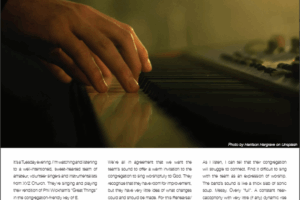Take this link to read the full article about Grant's More Than Music Workshops, as…

THE BOY, THE BED & THE BAND … FOR AUDIO TECHS
By Grant Norsworthy
I’ve learned a lot from seeing my sons bouncing on my wife’s and my bed. It seems that age three is the optimal age for this activity. Old enough to bounce without falling off the edge. Small enough not to damage the bed! First it was our oldest, Max, then the middle son, Marcus, and right now it’s our youngest, Casper.
This bouncing-boy-on-a-bed picture helped inspire and inform my musical choices during my days as a pro touring and recording bassist.
But these days I’m more often in the role of instructor and consultant for whole teams of Church instrumentalists, singers and technicians: Helping them craft a sound that is more inviting and engaging for the congregation. The applications for the bouncing-toddler illustration have grown exponentially into a way of thinking about music in general; giving a clear goal to work towards when crafting a band’s sonic quality that effectively engages a church congregation to worship God through songs.
Picture this: My 3-year-old son Casper leaping exuberantly through the air, arms flailing, face beaming, propelled by his little legs springing off mommy and daddy’s bed. It’s an engaging picture. It draws people in.
Think of the bouncing boy as the vocal melody and the lyric of the song. That’s the most important element of this picture and of our song. That’s what we are asking people to connect with, resonate with, sing along to.
The bed that Casper is bouncing on has two halves – mommy’s side and daddy’s side. These two halves of one whole in our band’s sound are the bass guitar and the drums – more specifically the kick drum. The parts being played by these two must be connected, solid, foundational and support the vocal melody and lyrics. They allow the boy to bounce!
The lower frequencies of these instruments, when mixed correctly, have the power to move people, shift air, create a vibe and groove for the music while never invading the frequency range – the sonic space – of the song’s melody. Given a suitable sound system, lower frequencies can be put to dynamic use while never making the band sound too loud or hurting any ears.
There are other elements to the picture – comforter, pillows, wall hangings and so on – that add interest and color to the overall picture. But the little boy will bounce without them. These are our guitars, keyboards, harmony vocals and any other instrumentation we might add. Any one of them is not essential to the success or failure of the song. They must not clutter the sonic space of the melody and the lyrics. Unless there is an instrumental passage to a song, they must never compete for the attention of the listener.
There is a myriad of practical applications from this illustration to how a band should be directed musically and how the band’s sound ought to be mixed. With any team I am instructing, in this order of priority, I work with purpose to:
- consolidate the song’s melody and unify the vocal style of the singers.
- make sure all vocalists are singing the same lyrics (and that they match the screens!).
- establish solid time-keeping and melody-supporting parts for drums and bass guitar.
- establish other instrumental parts that support, but never clutter the melody.
- make sure any harmony vocals are used sparingly and mixed lower than the melody.
- ensure an overall mix that has clearly audible melody supported by robust low end.
So what does this mean in practical terms for the audio technician? You may feel that only the last item on the list above is within your domain. That’s the only one you’re responsible for. You just mix, as best you can, whatever they are sending you. The rest, surely, is up to the people on the platform! But I would beg to differ. Your input is needed!
Most audio technicians that I know and have worked with – especially in church music situations – are very humble, unassuming people. They probably would not offer an opinion about the band’s singing and playing unless asked. They may not give their real opinion, even if they were asked. Maybe they tried in the past only to be ignored. They’ve given up!
But the audio technician has the most objective ears in the room. There might be things happening musically – negative things – that the instrumentalists and singers, and even the MD, are unaware of. If we can all agree that we are aiming for the bouncing-boy-on-a-bed sound, then we can communicate more feely as we move towards that agreed goal. The audio tech and the Musical Director (MD) must work together to make that possible.
So, audio tech, ask yourselves these questions:
- Can you hear vocalists singing with different interpretations of the melody, vocal styles or lyrics from each other? This is a big problem. Not just for the audio tech, not just for the singers, but for the whole congregation! You need one solid, consistent, unified, consolidated representation of the melody – hopefully from at least one female and one male voice – so that you can give that vocal melody the prominence and clarity in the mix that it needs. Can’t find the correctly focused “picture” of the bouncing boy? Ask for that to be rectified.
- Are the drums and bass inconsistent, mushy, not together? Are tempos wandering? Is there a tug-of-war between different instruments about where the beat is? Then you won’t be able to have the mattress for the boy to bounce on. Make this known to the musical director (MD). Get it fixed, or at least worked on.
- Are any of the instruments throwing pillows in front of the little boy’s face? Are they playing parts, with a volume level or tone that makes it difficult to give the necessary clarity to the vocal melody? Speak up!
- Are harmony vocals keeping you guessing about which vocalists are singing the melody? If you’re working with a group of singers, you’ll probably find that they want to sing harmonies a lot, and they’ll change who gets to do them from time to time. This makes it tough to consistently have the melody more prominent than any harmony vocals. If you’re uncertain about which vocalists are carrying the melody, speak to the MD. Work out a system so that you can always be sure and mix accordingly. My system: Decide on at least one male and one female singer to sing melody for the whole service. Any additional singers might sing melody too but, when harmony is utilized, you’ll know which mic lines to have mixed a little lower than your main melody mics. Make it as simple as possible. Mixing sound is tough enough without having to juggle a bunch of harmony-happy vocalists at the same time!
This is all dependent, of course, on a smooth, productive, clear flow of communication from console to platform and platform to console. I hope you have a great working relationship with the Musical Director and all the members of the team on the platform. Do they ask for your opinion? They may not think to do so. Most likely, that communication and relationship has room for improvement.
If you’re looking for somewhere to start with the process, share the idea of a the bouncing-boy-on-the-bed and how it relates to the overall sound that meets the ears of the congregation. Maybe share this article with the MD. The whole team. Get on the same page with what sort of sound we are aiming for and then move from there to speak about specifics.
This bouncing-boy-on-the-bed way of thinking about sound and music can help the whole team. Instrumentalists, singers and audio technicians alike can agree on a defined objective for our sound. This, in turn, can help each individual make better musical choices, and encourage the whole team to work together more effectively to achieve the agreed goal.
This article was first published by Worship Tech Director of the WFX Network on May 17, 2018.


